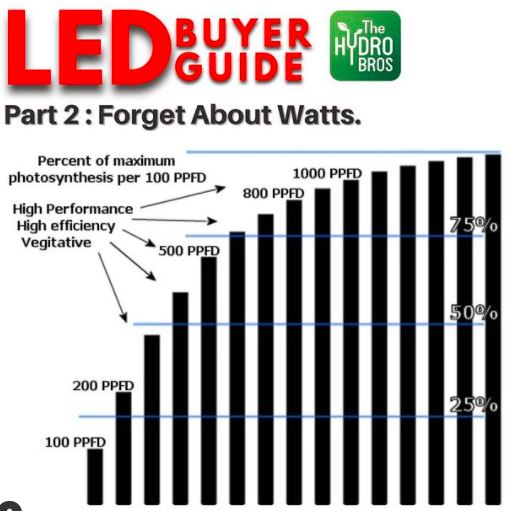LED versus HPS
HPS grow lights still and always will have their place, but the market is shifting and LED tech is way more efficient (less power for the same/more output) and vastly more affordable than it was a few years ago. For a small grow tent of 1.2m2 or less, we 100% always would recommend going LED.
Yes the cost outlay can be considerably more, but you’ll have fewer heat issues, ergo your extraction needn’t blare at max to deal with the heat, ergo your plants will be happier…and your neighbours aren’t wondering why you’re hoovering the house for 18 or 12 hours every day.
What is PAR, PPFD and why do I need to care? My mate is going to lend me his 1000w HPS grow light bro!
Firstly, 1000w is way too much for a small 1.2m2 grow tent (whether HPS or LED!) so leave it alone. Let’s slow down and take a look at what is important.
“Watts” are simply a measure of power 𝘪𝘯𝘱𝘶𝘵, what we're interested in, is the 𝘰𝘶𝘵𝘱𝘶𝘵; INTENSITY and EFFICIENCY. Let’s dive in:
What is PAR?
Photosynthetic Active Radiation: the “useful light” plants need. PAR refers to a specific range in the light spectrum (400 – 700nm) that plants need to photosynthesise (ie to grow and produce O2)
What is PPF?
Photosynthetic photon flux: this is the amount of PAR a light emits quantified in umols/second. Think of the light chucking out mini light atoms – we’ll refer to these as photons, and important to realise that not every photon will hit our plants. To take an extreme example, imagine a light with all its LEDs stuck on the top facing the ceiling, the PAR may be high, but that’s kind of pointless, which brings us to...
What is PPFD?
PPFD is the measure of the INTENSITY in a specific point; the measure of photons per second hitting our plant canopy, and expressed as umol/m2/sec. You’ll have seen PPFD maps (numbers on a grid usually) published by most manufacturers showing the number of photons hammering the specific grid across the map - they do this using a quantum meter aka par meter.
The PPFD chart and PPFD maps are a good guide, but there's no standard in how PPFD is measured/published which makes it difficult to compare charts from company to company! A good tip is to check that the hanging heights are the same when comparing PPFD maps, but mainly the overall efficiency rating which takes us to…
How to measure LED grow light efficiency? What is PPF/Watt?
This is the statistic on manufacturers specs you want to look out for, also known as “efficacy”. This looks at how many photons your light gives off (in any direction!) and divides it by the total input wattage. As a baseline for comparison of LED grow light versus HPS grow lights, an optimised 600w HPS grow light system (good reflector, high-quality HPS grow lamp) runs about 1.3umol/w as a reference from Shane Torpey @ Migro.
HPS or LED grow lights will both produce a certain amount of PPFD, but LEDs will pump out far more photons for less power. LED = more bang for the buck.
Watts is simply a measure of power 𝘪𝘯𝘱𝘶𝘵, what we're interested in, is the output; INTENSITY and EFFICIENCY. Let’s dive in:
How much PPFD do I need?
🤓 Current literature points to a sweet spot of between 600-900 PPFD in terms of maxing yield and maintaining a relative efficiency. In our graph, you'll see a diminishing return ie. the rate of photosynthesis is not tripled by tripling the amount of PFFD, there is an upper ceiling. Whatsmore, PPFD of 1000+ will require CO2 supplementation to be effective.
In summary, next time you visit your grow shop (hello!😉) ask about PAR output and look at all available PPFD maps, not just ones from the manufacturer!
FYI – we have the 👑 king of quantum meters landing (Apogee MQ500) so we can demo in-store, and have them available for purchase so you can optimise the hanging height of your light (rather than blast it full whack wasting energy your plants can’t absorb!)
As always, love to hear your thoughts, comments and experiences. Stay tuned 👍
#TheHydroBros
#ledgrowlights




